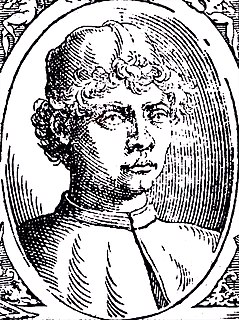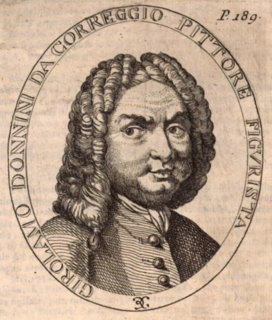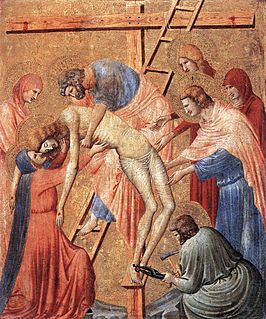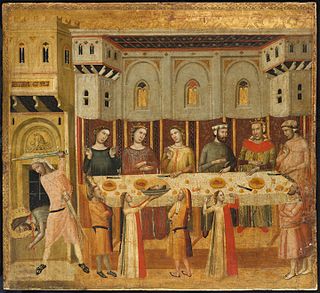Related Research Articles

Rimini is a city in the Emilia-Romagna region of northern Italy and capital city of the Province of Rimini. It sprawls along the Adriatic Sea, on the coast between the rivers Marecchia and Ausa. It is one of the most notable seaside resorts in Europe with revenue from both internal and international tourism forming a significant portion of the city's economy. It is also near San Marino, a small nation within Italy. The first bathing establishment opened in 1843. Rimini is an art city with ancient Roman and Renaissance monuments, and is also the birthplace of the film director Federico Fellini.

Piero della Francesca, originally named Piero di Benedetto, was an Italian painter of the Early Renaissance. To contemporaries he was also known as a mathematician and geometer. Nowadays Piero della Francesca is chiefly appreciated for his art. His painting is characterized by its serene humanism, its use of geometric forms and perspective. His most famous work is the cycle of frescoes The History of the True Cross in the church of San Francesco in the Tuscan town of Arezzo.

Guido Cagnacci was an Italian painter originally from Santarcangelo di Romagna. Associated most readily with the Baroque period, his mature works are characterized by their use of chiaroscuro and their sensual subjects. He was influenced by the masters of the Bolognese School.
Giovanni Battista Barbiani (1593–1650) was an Italian painter of the Baroque period, active in Ravenna. Among his works are altarpieces of St. Andrew and St. Joseph for the Franciscan church. For the dome of the chapel of the Madonna del Sudore in the Cathedral of Ravenna, he painted a fresco of the Assumption of the Virgin. He painted a ' St. Peter' in Sant' Agata in Ravenna. He painted in the style of Bartolomeo Cesi. Along with Cesare Pronti, he painted in the church of San Romualdo (designed by Luca Danesi, of the Camaldolese Abbey, now home to the Biblioteca Classense of Ravenna. The grand corridor in the Abbey is also frescoed by Barbiani with famous benedictine and camaldolese monks. His nephew Andrea Barbiani was also a painter in Ravenna and Rimini.

Vittorio Bigari was an Italian painter of the late-Baroque period.

Claudio Ridolfi (1560–1644), also known as Claudio Veronese, was an Italian painter of the Renaissance period.

Giovanni Battista Trotti was an Italian painter of the late-Renaissance period, active mainly in Piacenza, Parma, and his native city of Cremona.

Paolo Veneziano, also Veneziano Paolo or Paolo da Venezia was a 14th-century painter from Venice, the "founder of the Venetian School" of painting, probably active between about 1321 and 1362. He has been called 'the most important Venetian painter of the 14th century'. His many signed and dated works, some in collaboration with his sons, range between 1333 and 1358. He was regarded as the official painter of the Venetian Republic.

Girolamo Donnini was an Italian painter of the Baroque period, born in the town of Correggio, Emilia-Romagna. He was a pupil of the painters Francesco Stringa in Modena, and then of Giovanni Gioseffo dal Sole in Bologna, then traveled to Forlì to work with Carlo Cignani.

Cesare Pronti was an Italian painter of the Baroque period, active mainly near Ravenna.

Andrea Boscoli was an Italian painter of the Renaissance.

Domenico Robusti, also known as Domenico Tintoretto, was an Italian painter from Venice. He grew up under the tutelage of his father, the renowned painter Jacopo Tintoretto.

Pietro da Rimini was an early 14th-century Italian painter.

Francesca da Rimini and Paolo Malatesta appraised by Dante and Virgil is a composition painted in at least six very similar versions by Ary Scheffer between 1822 and 1855; all are in oils on canvas. The paintings show a scene from Dante's Inferno, of Dante and Virgil in the shadows to the right viewing the murdered lovers Francesca da Rimini and Paolo Malatesta in Hell. It "could be described as Scheffer's best work".
Antonio Cimatori, called Il Visacci was an Italian painter.

Giovanni Baronzio, also known as Giovanni da Rimini,, was an Italian painter who was active in Romagna and the Marche region during the second quarter of the 14th century. His year of birth is unknown. Giovanni Baronzio was the eminent representative of the second generation of painters of the school of Rimini who were influenced in by the activity of Giotto in Rimini.

Niccolò Frangipane was an Italian artist of the late Renaissance period.
Giovan Francesco Buonamici was an Italian architect and painter of the Baroque period, active mainly around Ravenna, Fano, and his native Rimini.
Giovanni Francesco Nagli was an Italian painter of the Baroque period. He was a follower of the style of Simone Cantarini and later of the prominent Baroque painter Guercino, who was born in Cento in what is now Emilia-Romagna. It is perhaps for this latter reason, Nagli as follower of Guercino, is called il Centino, despite being mostly active in Rimini from 1629 onward. He painted a Sant'Agostino at his desk, now in the Pinacoteca of Rimini. He painted a saint at the gallery of Cesena. He painted a Bambino killing a Dragon at San Francesco Saverio, Rimini. He painted an altarpiece depicting St Anthony of Padua preaching to the Fish, which was once the main altarpiece of the Church of the Theatines, Rimini
Francesco Brici (1870-1950) is an Italian painter, born and active in Emilia-Romagna.
References
- Federico Fellini, Mario Guaraldi, Loris Pellegrini: la mia Rimini, 2003, p. 31
- Bryan, Michael (1889). Walter Armstrong; Robert Edmund Graves (eds.). Dictionary of Painters and Engravers, Biographical and Critical. Vol. II L-Z. London: George Bell and Sons. p. 25.